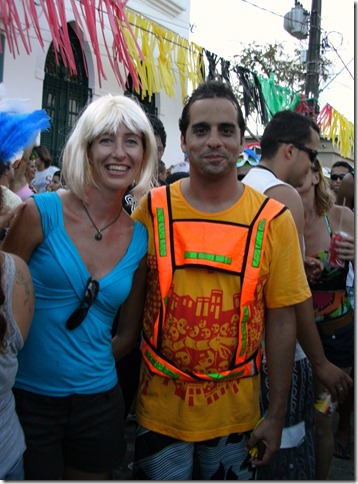Lat: 05 58.268′ S
Lon: 34 59.672′ W
Bus drivers in Recife are madmen. They sit stone-faced behind the wheel while you board, giving no indication at all of what’s about to happen. The driver works with a second person who collects fares, and on the smaller busses, also hangs out the open bus door, calling to people gathered on the street where the bus is going, trying to fill the bus until it’s overflowing. Once the new passengers are far enough up the bus steps that the door can be shut, the driver hammers the accelerator like he’s attempting to establish the new 0-60 record time for a bus loaded with 30 people. Being small boat blue-water sailors, we’re quite accustomed to motion, but several of us nearly lost our footing on more than one occasion. We quickly learned that just like sailing through a storm at sea, holding on securely was the only way to stay on your feet. Stopping was so sudden that it made me suspect the drivers are taking bribes from brake-pad salesmen. One bus we were on actually squealed its tires while braking for a car that it had attempted to beat for the lead spot as the road ahead narrowed to one less lane. Busses that begin braking at the point someone is standing on the sidewalk and trying to flag them down aren’t uncommon, and you usually don’t have far to walk once they’re stopped.
Thibaut from RDJ and I climbed aboard one of these busses Monday morning. We each had 3 jerry cans for diesel and managed to somehow squeeze them and ourselves aboard the packed bus and stay upright while the bus roared off and we found a place to stand. The port captain’s office opened at 8am and we were hoping to be there around then as our check-in had taken over 30 minutes, most of it waiting for a photocopy to be made. The port captain’s office in Recife is essentially a small Navy base, and copies are only e copies and then don, who are summoned to make the copies and then don’t reappear for 20-30 minutes.
During Carnival the complex had been virtually empty, but it was bustling when we arrived and after explaining why we were there, we were shown to a waiting room. After 15 minutes or so, one of the junior seamen (there was a mysterious absence of officers) walked over to explain that we would be waiting another 30 minutes or so as the person we needed to see was currently playing soccer and the game wouldn’t be over for a while. We stuck our heads into the courtyard, and sure enough, there were a good number of guys playing a rousing soccer game during Monday morning business hours. That’s Brazil. So much for coming early. It took an hour for our guy to finish the game, shower, and get ready to see us. I finally went up to the main desk when an officer showed up and he waived Thibaut and I over. I explained our business and he said OK, no problem, just go to the waiting room and sit down. Our second hour at the port captain’s office was spent occasionally handing over a paper or passport or answering a question while we waited. Finally, we received our clearances and headed out. Very friendly, but more than 2 hours to have someone write something about our next port on our entry document and give it a stamp. The formalities are different in every country and each one takes their papers and processes very seriously, so it’s best just to have a sense of humor, a smile, and bring a book to read.
Our next errand seemed pretty basic as well: buy some diesel on the way back to the yacht club. We flagged down a taxi, but the first gas station didn’t sell diesel. The second station did, and we unloaded our jugs and showed the attendant our credit cards, explaining in basic Portuguese that we wanted to buy diesel and pay with “Visa”. It seemed like a pretty straightforward concept, but the head attendant was yelling at us like we’d made a major mistake. We tried offering to pre-pay, but that didn’t seem to satisfy him. There was evidently some mysterious complexity to buying diesel that our rudimentary Portuguese couldn’t unlock and he wasn’t at all happy about it. Finally, he took my card, ran it for the cost of filling one jug, and after it was approved, he turned into Mr. Happy. They filled the rest of our jugs, we paid, and had no more problems. The head attendant even had several questions about our trip, which he thought was crazy enough to be funny.
Cabanga Yacht Club can only be reached at high tide, and we finally managed to pull away a couple hours after high-water. With the half-moon and our shallow draft, we figured we’d be fine and we were. The only drama was that our port engine wouldn’t start. It seems to be an electrical or starter problem, so we elected to take off anyway and work on it at sea. Not having the second engine required maneuvering with an extra line, but it went off without any major dramas.
This is one of the first times we’ve left without a favorable weather forecast. Our pilot charts indicateecast this week was for north and NNE and most of it less than 10 kfor north and NNE and most of it less than 10 knots. rth and NNE and most of it less than 10 knots. With no weather improvement in sight, we decided it was better to get moving toward the Caribbean and make the best of the wind we got. While we’d hoped that the GRIB files were wrong enough that we could make our planned stop at the beautiful offshore marine paradise of Fernando de Noronha, it hasn’t worked out that way.
We’ve been close-hauled the whole time since leaving, averaging 2-3 knots, with speeds as low as 0.6 knots and as high as 8 knots in squalls. We’ve had to motor a bit when the wind completely died and tack in the opposite direction of Barbados at times, but we’re slowly working our way toward the open water north of Brazil. We have had a couple of incidents. Our first night we were hit by what was one of the worst squalls we’ve ever had. It was after the moon had set, so it was too dark to see it coming and it came on very quickly. The wind picked up to 30-40 knots and we had the full main and genoa out. Lauren was on watch, and right after she called me on deck it started raining so hard that it was difficult to keep my eyes open. We were lucky to get the sails down without any damage, especially since the roller furling line jammed for the first time that I can recall. We hadn’t made it very far offshore at the time, and with the wind pushing us toward the reefs that line the coast, it was a pretty intense 5 or 10 minutes.
The next morning I was on watch, about 12 miles offshore making about 2 knots in a hot, light breeze, when the insects of the the rain forest attacked us en masse. Hundreds and hundreds of gnat-like bugs led the charge, but flies, grasshoppers, butterflies, and other bugs joined in as well. There were so many bugs in some places that if you slapped down on them with your hand and turned it over you c but I was afraid thss te’d be a floag at a time, but I was afraid that we’d be a floating gnat colony f was afraid that w’t do sometoating gnat colony for weeks if I didn’t do something, so I closed the doors and hatches to keep them out of the boats interior, started an engine to create some apparent wind, and turned the boat offshore to get away from land. I then started using a flip-flop as a fly-swatter and the deck soon began to look like a bloody, medieval gnat battlefield. Flies and gnats both seemed to be attracted to the corpses, so several spots became especially dense with small black and red smudges. Eventually the tide of the battle started to turn in favor of Pura Vida and within a couple of hours I was able to open the boat back up with only the occasional wily straggler to hunt down.
The AIS seems to have taken a permanent vacation, so we kept busy last night tacking in light winds, dodging ships and fishing boats, staying far enough offshore to be safe from the reefs, and still managing to make a little northward progress. We’ve had a couple of visits from very large, gray dolphins, but we’re a little too slow at the moment to keep them interested, so they’ve left after a quick look. The good news is that we’ve been able to sail since yesterday afternoon and are on a course that will let us clear the eastern point of Brazil by tomorrow night with only one more tack if the wind holds.
Once again, our time on land has flown by, but thanks to our self-appointed tour guide, Bruno, we have managed to take in some memorable sights and navigate our way around the city without too many complications. Tracey and I initially met Bruno when we were in Olinda for Carnival. He approached us and began to speak to us in English as many others did, but unlike most others, he could speak English quite well. He explained that he had spent two years in San Diego as a child while his father, a physicist, completed his post-doctoral education. Bruno was a little timid at first but warmed up quickly, and we enjoyed our brief meeting with him. As it turned out, the French crew from S/V RDJ met him the following night in Olinda, and he took them around the backstreets to an extended Carnival celebration. They really appreciated his interest in them and assistance and invited him to a BBQ the following evening. He did not attend but showed up at the yacht club the following morning to express his regrets. As I did not realize that he was the same Bruno who had served as the guide for our French friends, I was pretty surprised to see him there!
Ever since that morning, Bruno has been around, translating for us, helping us find the right buses to the various shops that we needed, and suggesting “touristic” activities. For starters, he helped us communicate to the yacht club regarding the outrageous bill we received for our laundry – about $80 for the three of us! Considering that the clothes being washed were those that we had worn on the passage from St. Helena (“passage clothes”), they were hardly worth the cost of the wash! We thought it was a bit unusual that they wanted us to write down each item of clothing when we dropped off the laundry, but we didn’t realize that they charged $1 and $1.5 for each small and large item, respectively. This is but one example of the difficulties that can arise when you don’t speak the same language!
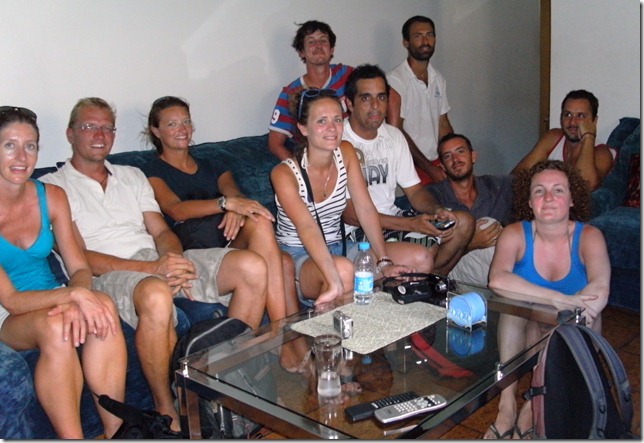 The crew of S/V Pura Vida and RDJ with Bruno (in center) at his house (photo by his very sweet mother)
The crew of S/V Pura Vida and RDJ with Bruno (in center) at his house (photo by his very sweet mother)
Yesterday Bruno took the three of us along with three from S/V RDJ to a couple of beaches about an hour and half away. We took two buses and the metro train to get there, so obviously it would have been quite complicated if he weren’t leading the way. The first beach, Porto de Galinhas (called the Port of Chickens because boats that were importing slaves used to say they were carrying chickens), was full of Brazilian families enjoying the beautiful day and hiring lateen rig sailboats to take them out to a small rock enclosure full of small fish. Bruno and I swam out so that I could see what the fuss was about. We arrived at one very shallow spot where there were small sea urchins with sharp spikes to be avoided, but we made it through and entered the enclosure to find hundreds if not thousands of medium-sized (8”) white fish with black vertical stripes. A school of fish approached us immediately in hopes that we would feed them. As they swarmed around us, some friendly Brazilians gave us a handful of little pellets so that we could satisfy the fish. Bruno was happy to have led me to my first aquatic fish-feeding experience (usually we are trying to eat the fish, not feed them). The second beach was Maracaype, a very beautiful surfers’ beach with far fewer people. Dallas donated our surfboard that we haven’t been using to Pierre from S/V RDJ who was keen to repair the dings, and Pierre demonstrated that despite the sloppy conditions, he knew how to use it. We all enjoyed the live reggae music and the awesome vibe before jumping on a very crowded and lively minibus to begin to make our way back to Cabanga.
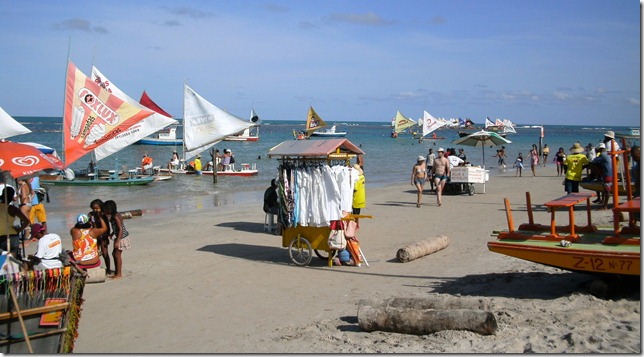 The busy beach of Porto de Galinhas (the fish pool is in the back on the right)
The busy beach of Porto de Galinhas (the fish pool is in the back on the right)
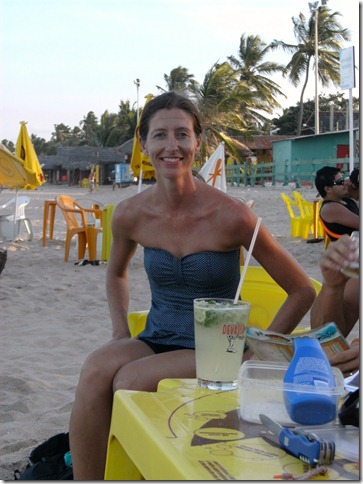 Tracey enjoys a Caipirinha on Maracaipe Beach
Tracey enjoys a Caipirinha on Maracaipe Beach
We stopped to get some final provisions on the way back and had our hands full, but again, the Brazilian people were extremely accommodating. People quickly made room for our groceries on the crowded minibus to Bruno’s house, where we had dinner. His brother then gave us a ride to the bus stop, but as we waited, one of Bruno’s friends happened to drive by and gave us a lift all the way back to the yacht club. This is one place where they definitely like gringos! Oh, and I must mention that despite that Carnival ended last week, it seems that the party hasn’t stopped yet. Bruno told us yesterday that yes, it is still a holiday, because it’s the weekend!
In terms of other business, we just received our spinnakers back with patches intact and have filled up our diesel and water in preparation for the long passage through the doldrums to the Caribbean. We had hoped to sail next to Fernando de Noronha, a marine reserve 300 miles from here with noteworthy sea life, but it looks like the light winds that are predicted are going to be coming from that direction, so we may have to give it a miss and head straight for Barbados. It is time to get back to sea, so we have to say good-bye to Tracey and Bruno and the RDJ crew, but we hope to see them all again soon. We also must say a big obrigado (thank you) to them and to Brazil!
It felt like we were on a conveyor belt toward the end of the passage. The closer we got to Brazil, the slower we seemed to go (i.e., 3 knots), and I was concerned that we were going to just miss the Carnival celebration. Fortunately, the wind picked up on the last night, and we were able to sail rather than motor for the last leg. We arrived at Cabenga Yacht Club in Recife on Monday afternoon, and after some awkward gesturing from me and some Spanish-speaking (similar to Portuguese) from Dallas, we finally understood that while there were no slips available, the yacht club staff intended to help us tie up to other yachts.
The marina was full of yachts participating in the Atlantic Rally for Cruisers (ARC), and we have enjoyed catching up with the crew from those boats who we met while in Durban. In particular, Bev and Mo are a really nice English/Iranian-English young couple who are crewing on a large catamaran. After we thoroughly enjoyed a dip in the yacht club pool and a couple of cold Brazilian beers, Mo gave us the run down on the area and invited us to join them for a trip to the Recife Carnival that night.
The Recife Carnival was quite civilized considering the size of the crowd. People of all ages walked through the streets of the city and converged around several stages to hear their favorite bands. It seemed that everyone knew the words to all of the songs, which we found remarkable considering the range of ages of the party-goers. Of course there were stalls of food and drink all along the street, and the grilled chicken or beef on a stick and caipirinha drinks (sugar and lime mixed with cachaca, similar to rum) seemed to be popular items along with the ubiquitous cans of Skol, the local beer.
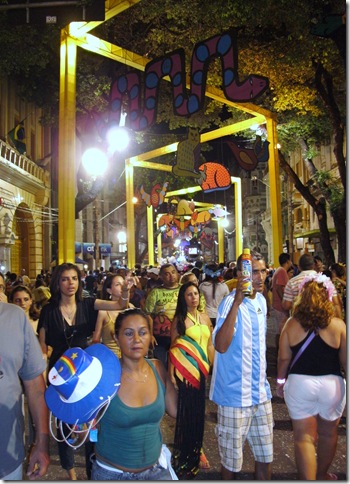 Recife Carnival
Recife Carnival 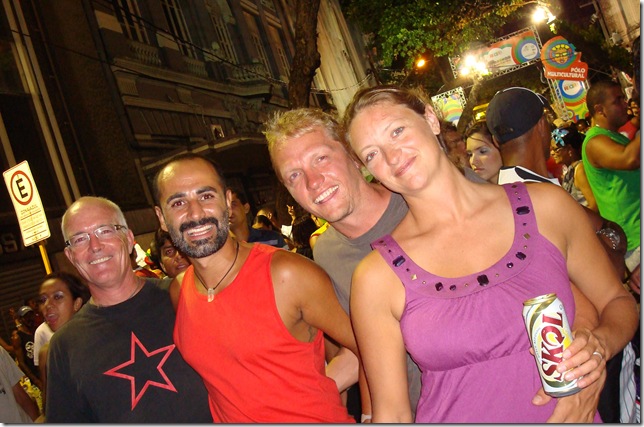 Bob and Mo helped us get our first taste of Brazil
Bob and Mo helped us get our first taste of Brazil
What impressed me the most was definitely the people. They were in good spirits, moved through crowded spaces without being aggressive or even the least bit annoyed, and, if they spoke any English at all, attempted to make conversation with us. Moreover, when it started pouring down rain, the party-goers casually moved along the sides of the street in search of shelter or simply danced around, enjoying the relief from the heat.
We returned to the yacht club at a reasonable hour, but I woke up with a headache, probably from the two, sugar-filled caipirinhas. Nevertheless, we set off for the airport to clear in with immigration. The official who stamped our passports also had attended Carnival and had had far less sleep than us! But after a good 15 minutes, he completed the requisite paperwork and bid us adeus. We then managed to get some local money (rials) from the 10th ATM that Dallas tried. Apparently many banks don’t process transactions with international credit cards!
Dallas planned to complete the check-in process that afternoon, so Tracey and I made our way to Recife’s sister city of Olinda to check out their version of Carnival. We had been told that it had more of a community atmosphere, and I would definitely agree. The town itself was lovely with narrow cobble-stone streets and brightly colored buildings, and the throngs of young people in attendance attempted to walk shoulder to shoulder within the primary intersections. Most had some form of costume on, and cartoon characters were well represented. (Oddly, the Flintstones seemed most popular.) Tracey and I decided to get into the act and sported wigs, hers a platinum blond, and mine an afro. Yet again, music seemed to be the main attraction, but rather than coming from bands on a stage, it was from small marching bands parading through the streets with a stream of followers behind. We had a great time walking the streets and taking in the sights, sounds, smells, and tastes, and it was well worth the difficulties involved in finding the correct bus and getting back to the yacht club (a 2-hour process).
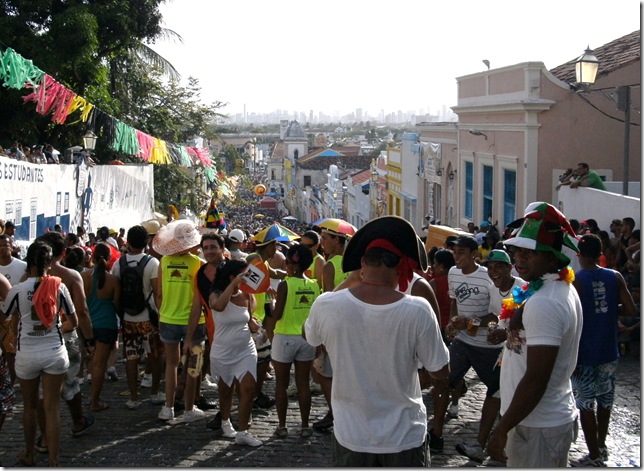 Olinda Carnival was more “democratic”, as one Brazilian put it
Olinda Carnival was more “democratic”, as one Brazilian put it
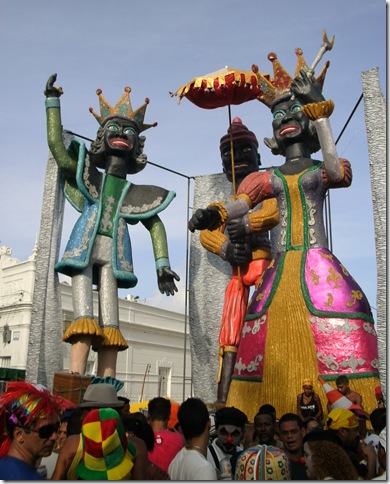 Olinda’s local artists prepare for months in advance with impressive results
Olinda’s local artists prepare for months in advance with impressive results
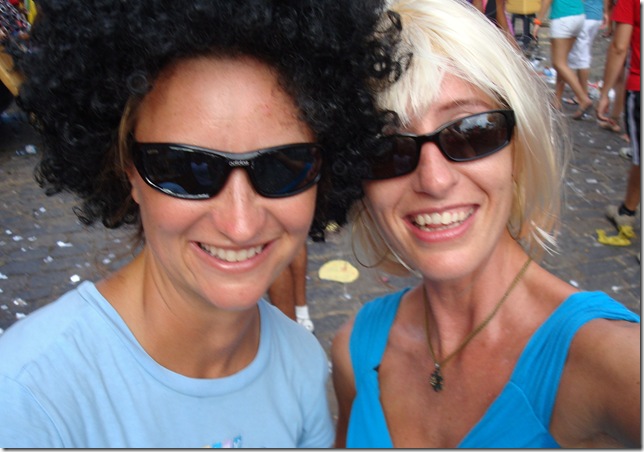 Tracey especially liked her new do
Tracey especially liked her new do
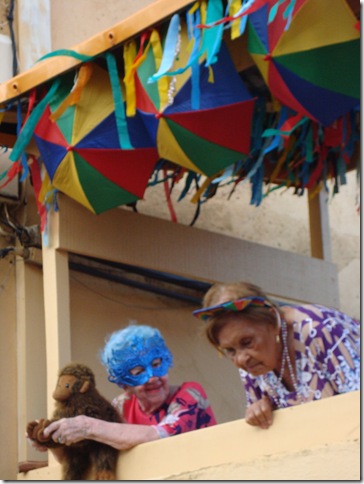 Never too old for Carnival! (photo by Tracey)
Never too old for Carnival! (photo by Tracey)
Our friends from S/V RDJ just arrived, so there is sure to be more partying in our future…


